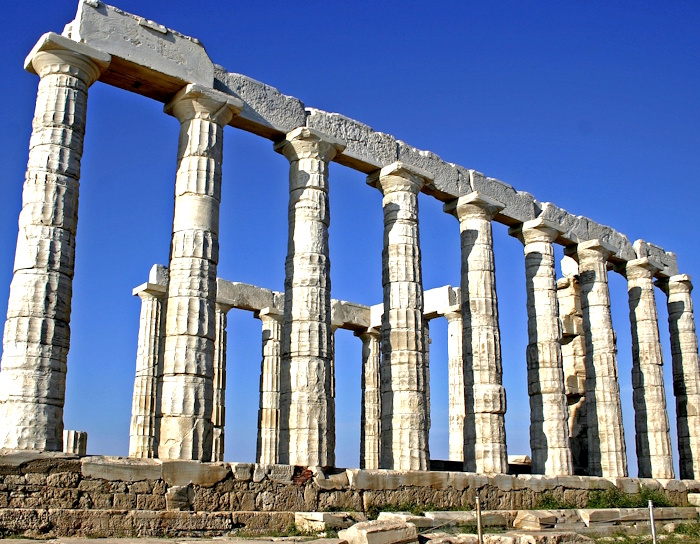The Temple of Poseidon at Cape Sounion is one of Greece’s most famous landmarks and a popular day trip destination (bus excursion) for tourists from Athens. With its spectacular location on a cliff high above the Aegean Sea, the temple offers not only historical significance but also breathtaking views and impressive sunsets.

>>> Bus tours from Athens to Cape Sounion and the Temple of Poseidon: Click here
Location and Arrival
The Temple of Poseidon is located at the southernmost point of the Attica peninsula, about 70 kilometers from Athens. It sits at a height of about 60 meters above sea level on a cliff that offers sweeping views over the Aegean Sea. The view is particularly impressive at sunset, when the light bathes the temple’s white marble in a golden glow.
Arriving by Car
Along with an organized day trip by bus, arriving by car is the most convenient way to reach Cape Sounion. From Athens, follow the coastal road Poseidonos Avenue (Route 91), which runs along the so-called “Athens Riviera.” The journey takes about 1.5 hours and offers many opportunities to explore small beaches and charming coastal towns along the way.
Bus Connections from Athens
There is a regular bus service between Athens and Cape Sounion, operated by KTEL Attikis. Buses depart from the “Pedion tou Areos” station in central Athens. The journey takes approximately two hours, depending on traffic. The buses stop at several coastal towns along the route and offer an affordable way to reach the temple.
Guided Tours from Athens
Several tour operators offer half-day or full-day tours from Athens to Cape Sounion. These often include a comfortable bus ride starting at around €18, informative guided tours on the history of the temple, and sometimes even stops at beaches or tavernas along the coast. These bus excursions are particularly suitable for visitors who prefer a stress-free and informative trip.
>>> Bus Tours from Athens to Cape Sounion and the Temple of Poseidon: Click here
History of the Temple of Poseidon
The temple was built in the 5th century BC and was dedicated to the sea god Poseidon. The choice of its location was strategic: Cape Sounion was an important point for sailors and offered an opportunity to thank the gods for a safe passage. The temple was built on the foundations of an earlier structure and was part of a larger sanctuary that also included a fortress wall and other smaller buildings.
The famous travel writer Lord Byron is said to have carved his name into one of the marble columns during a visit in the 19th century—a legend that fascinates many visitors.

Visitor Tips and Opening Hours
The Temple of Poseidon is open daily, although opening hours vary depending on the season. In the summer months, it is usually open until sunset – a great opportunity to enjoy the famous evening light.
Admission Prices
Regular ticket: approximately €10, in winter (November to March only €5).
Reduced ticket (students, seniors): approximately €5.
Children under 6 are admitted free.
Best Visiting Times
The best time to visit is in the late afternoon, when temperatures are more pleasant and you can experience the spectacular sunset. If you want to explore the temple in peace, you should come in the morning before the tourist buses arrive.
Practical Tips
Sun protection: Since there is hardly any shade on the cliff, sunscreen, a sun hat, and a water bottle are a must.
Comfortable shoes: The temple is located on rocky terrain, so sturdy shoes are recommended.
Don’t forget your camera: The view is unique and perfect for impressive photos.
A visit to the Temple of Poseidon at Cape Sounion is one of the best ways to experience history, nature, and impressive views in a single trip. Whether by car, bus, or as part of a guided bus tour, the trip is definitely worth it. It’s especially romantic at sunset, when the temple is bathed in golden light and you can let your gaze wander over the vast sea.